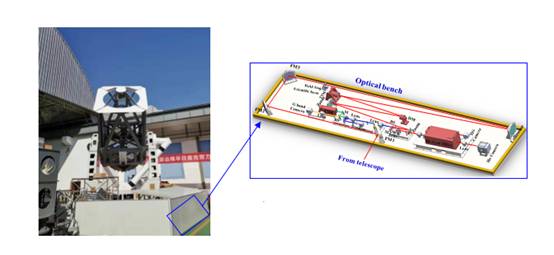The First 2m Class Solar Telescope in China
Recently, the solar high resolution imaging technology research team led by RAO ChangHui, senior researcher from IOE, has successfully developed the 1.8m solar telescope. The telescope has obtained high-resolution images of the solar atmosphere photosphere and chromospheres through its first light.
The sun is the nearest star to Earth, its activity will directly affect human life. Especially for the large-scale solar eruption activities, it will project electromagnetic radiation and particle radiation to the sun-earth and earth space, which will cause severe disturbances to the ionosphere, magnetosphere and atmosphere, affecting the ground communication and power supply. Therefore, monitoring and studying the solar activity and its space environment impact has always been one of key research directions in the world.
The international communities have been working on building solar telescopes with 2m class and larger aperture. At present, the 2m class solar telescopes that have been completed mainly include the American 1.6-meter solar telescope GST and the German 1.5-meter solar telescope GREGOR. The 4m solar telescope DKIST in United States has not yet officially operated, and the 4m solar telescope EST in Europe has begun design and development. The largest existing solar telescope in China is the 1-meter new vacuum solar telescope developed by Yunnan Observatory.
With the support of National Natural Science Foundation of China (NSFC) and other funds, the research team has carried out a series of basic theoretical researches such as photothermal effect and low-contrast extended target wavefront detection. With the breakthrough in key technologies such as large-aperture solar telescope main mirror thermal control technology, real-time wavefront detection technology under strong turbulence, and large field of view solar adaptive optical correction technology, the team has successfully developed the 1.8-meter solar telescope.
1.8m solar telescope is the first 2m class solar telescope in China, and the largest solar telescope that has been built in the world. The telescope is equipped with a 451 element high-order solar adaptive optical system, a ground surface adaptive optical system (GLAO), and a solar multi-band high-resolution imaging system. In the first light observation, the telescope has obtained the high-resolution imaging observations of solar atmosphere photosphere layer (G-band: 430.5nm and TiO-band: 700nm) and chromosphere layer (Ha-band: 656.3nm).
In order to obtain more comprehensive solar activity monitoring data to support the solar physics research and space weather forecasting business, the 1.8m solar telescope will also be equipped with a solar multi-layer conjugate adaptive optics (MCAO) system, a high-resolution magnetic field and velocity field detection system in the solar active area and other system.
The achievement of 1.8m solar telescope has been highly evaluated by international peers and will be published in the journal of Science CHINA: Physics, Mechanics & Astronomy.

Figure 1. 1.8-meter solar telescope (GLAO and 3-band imaging system on the right)

Contact
CAO Qiang
Institute of Optics and Electronics
Email: caoqiang@ioe.ac.cn
